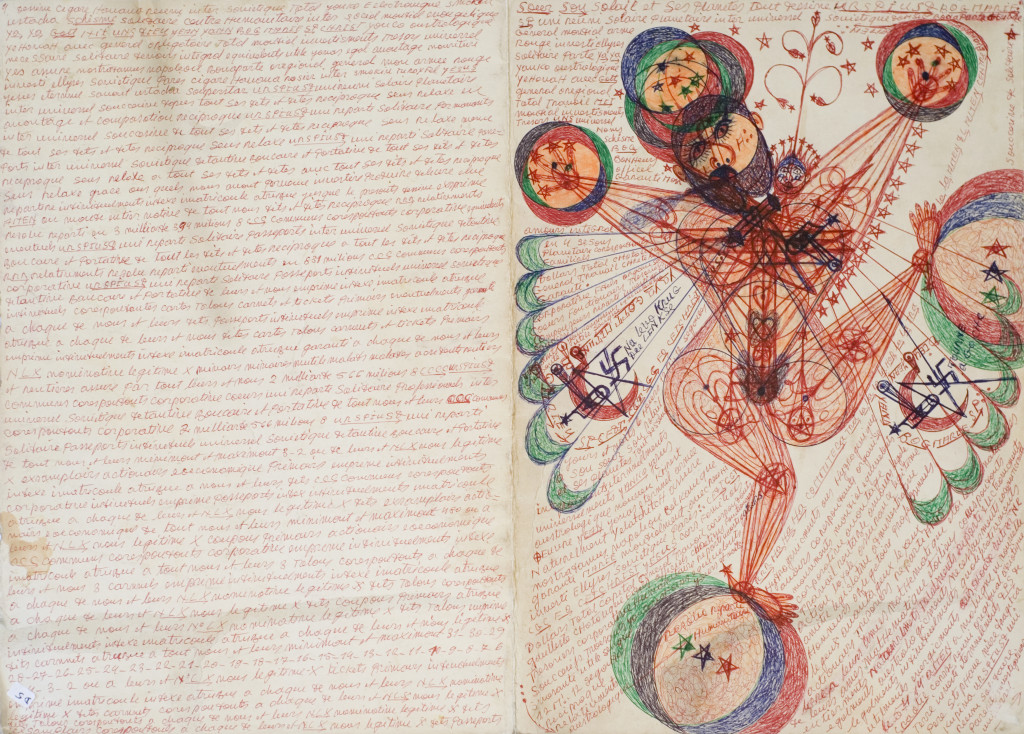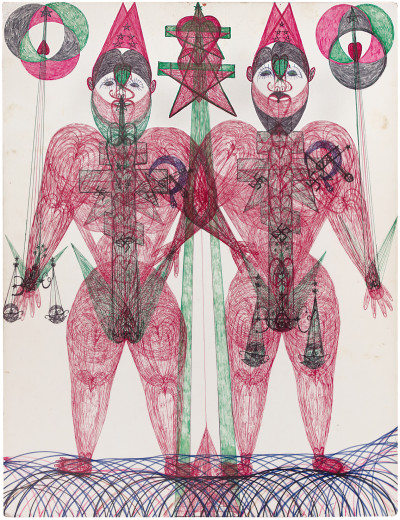janko domsic
the celestial mechanic
The Domsic comet, which first appeared in Paris nearly forty years ago, is known only from the traces it left in its wake. The mystery shrouding Domsic’s life and work is far from close to being resolved.
He was discovered by Alain Bourbonnais, founder of La Fabuloserie, who had recently set up his own gallery, the Atelier Jacob, in the street of the same name. Hearing about some curious drawings on show in a group exhibition held at the town hall in the 3rd arrondissement – which otherwise sank without trace – he eventually tracked down the artist, Janko Domsic. Domsic was born in Malunje, Croatia, in 1915. The little that is known of his life comes from clues scattered thinly in an unstoppable flow of words wrapped in a layer of mysticism. It is thought that he arrived in France in somewhat murky circumstances, perhaps spending some time in prison before working as a navvy on the Pont-sur-Yonne railway in around 1935; he recounted how some of the sleepers still bear his name, carved with an axe. He eventually moved to makeshift digs on the sixth floor of an apartment building near Montmartre cemetery in Paris, where he lived until his death in 1983. Since there was not enough room there to work on his art, he preferred to swap his secret lair for the bustling anonymity of a city café.
There, he became the divine creator of his own artistic world, which, like Domsic himself, has not yet revealed all its secrets.
“I never went to school, not for a single day, so I learned to write my first letters with the gypsies”, he proclaimed, while at the same time touching on an ambition which sheds light on the importance of text in his art: “I’m a writer, I was always looking at the general and international economy, listed in dollars”. Looking at his oeuvre, this might at first appear like a joke; in fact it highlights one of the major characteristics of his art – the unbreakable bond between writing and drawing. Like so many other Art Brut creators, Domsic’s art represents the graphic, whether written or drawn.
In fact, he claimed that his works were destined for publication. It may thus be the case that he did not use drawing simply as a means of developing an arsenal of symbols, but also as a way of making his somewhat abstruse texts more accessible4. “My writing is in code”, he would say. And it is true that whatever the proportion of text in his compositions – and those entirely devoid of text are rare indeed – it is immediately apparent that it is the result of an extremely elaborate system. There is the use of his patronym, first of all, transcribed phonetically with an immigrant’s irony as “Domchitch”, along with a number of invented middle names – Janko Bonsang Halleluya Domchitch – which are indicative both of the artist’s sense of humour and his heavenly calling. The name is even officially recorded on a document from the Paris police authorities
Near his name are the letters BOG, or God in Croatian. Is he laying claim to the official title? Here and there, the acronym U.R.S.P.I.U.S. (United, Resolute, Solar, Planetary, Index, Unify, Stratmospheric) completes – if completion were needed – the list of the author’s titles, if not his intentions. And in fact, quite apart from the impression of scansion, repetition, even litany, his texts betray a flair for coining neologisms which, over and above their apparent cacography, function, like his drawings, on the basis of agglutination and fusion.
He is a demiurge, a builder, an organiser, all at the same time. As Zora Fitting has written, “The geometric spirit of Domsic’s drawings betrays his use of ruler and compass – two tools used by builders and associated with freemasonry”. He strives for a form of syncretism, revealing an eschatological urge to create a new order, of angels, one might say; his compositions are their celestial map. His characters often have wings or appear to be perched on rainbows or clouds, ready to strike out towards their destiny.
They are barely encumbered with a few earthly symbols, religious, political, or economic. These ambivalent creatures, their tense poses contrasting with the airy weightlessness of their mechanism, certainly originate from their secretive creator, with their solid beliefs and fragile aspirations. The work as a whole is destined to melt into a hitherto unseen absolute which has not yet unveiled all its mysteries. Sitting in his Parisian café, Domsic produced one of the most complex and enigmatic oeuvres of all Art Brut artists, as well as one of the most beautiful in Platonic terms.
All this, despite the fact that all we see is the tail of the comet, far in the distance, in the “oregional” spheres.
Janko Domsic was, among many other things, a demiurge, a builder, an organizer, and an artist. It was in his makeshift dormitory not far from the Montmartre cemetery, in Paris, that this Croatian exile made his celestial compositions, filled with religious political and Masonic symbols. “My writings are coded.” His drawings, like the texts that accompany them, respond to a very elaborate system. Magnified in the exhibition Art brut, works of the Antoine de Galbert collection, in 2015, at the maison rouge (Paris), his pieces appear in all the major world collections, both public and private, of art brut.

Foreword : Christian Berst
Catalog published to mark the exhibition Janko Domsic : the celestial mechanic, from October 17th to November 22th, 2008. Extended and revisited version, 2018.

